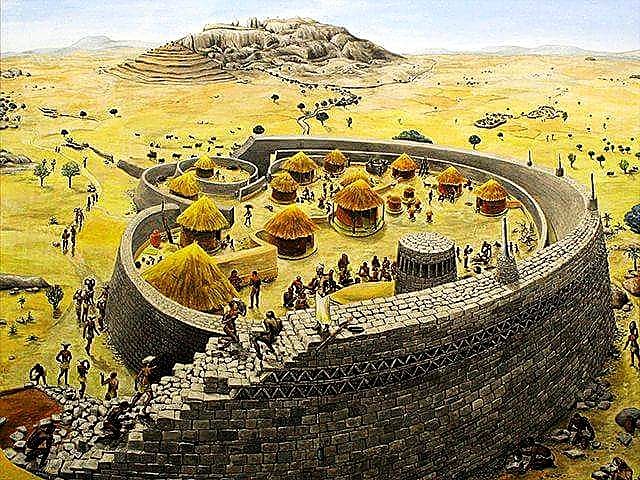The people currently known as theKalangaorBaKalangahave been residing in Western Zimbabwe and Eastern Botswana for over a thousand years.
Archaeological evidence indicates that the Kalanga originated in Northeast Africa, specifically in the Egypt-Sudan-Ethiopia region. Like many Bantu groups, they migrated from the North down to the South, finally settling in the area that is modern-day Southern Africa.
The difference with other groups is that the Kalanga settled south of the Zambezi about two millennia ago. By 100 AD, they had already settled in the lands now called Zimbabwe, Mozambique, South Africa and Botswana, with most groups arriving between 500 and 1700 years later (the Sotho-Tswana about 500AD, the Nguni about 1600 and the ‘Shona’ about 1700).
At that time, the names “Kalanga,” “Munhumutapa,” or “Tjibundule” had not yet been heard of, and their chief was also unknown. However, when those tribes from the North split up, a chief emerged of those people who went on to be called “The Kalanga”. That chief was Hamuyendazwawhose name in Kalanga means‘punisher of the people’.The name Hamuyendazwa, by itself, references to the switch of the bush called ndazwa, whose very soft and flexible branches were, according to the Kalanga, used by baboons to punish their young ones. Thus, because of his tendency to doling severe punishment with that ndazwa whip(hamu), the name of Hamuyendazwa (the punisher –uno langa), stuck. Consequently, those followers whom he ruled were, in turn, referred to as‘the people of the punisher’orBannu Baka –Langa.
Hamuyendazwa was already well entrenched in his reign before the arrival of the Portuguese and he was the predecessor of the first Munhumutapa. By 500AD, the Kalanga had established an Iron Age culture known as the Leopard’s Kopje Culture which was the first in Sub-Saharan Africa to engage in mixed farming and also mine and trade in metals such as gold, copper and iron. By 1000AD, the Kalanga had become a sophisticated people, establishing the first city-state in Sub-Saharan Africa, the Mapungubwe, on the confluence of the Limpopo and Shashe Rivers.
From Mapungubwe, the Kalanga expanded their state, improving over time the tradition of building stone walled settlements until it reached its apex at Great Zimbabwe and later Khami. Within the next 200 years of its existence, Great Zimbabwe became a powerful capital controlling trade with the east coast and it grew into a large state that extended from the Mozambican coast, north-eastern Zimbabwe, the Northern Province of South Africa and as far as the Makgadikgadi Pans in Botswana. The Monomotapa Kingdom which was centred at Great Zimbabwe, existed for 500 years (1000-1500 AD) and it was the greatest polity in Southern Africa. However, it later disintegrated as a result of external attacks and internal decay. It would be superseded by the Butua and Togwa Kingdoms of BaKalanga whose chiefs were the Mambos headquartered at Khami, 22km south west of Bulawayo.
Although, the Kalanga had grown and become a cohesive nation, however, by the time the Portuguese arrived, Hamuyendazwa had died. The ruler they found in place instead was Malambodzibgwa(which means, ‘he who refuses to be restrained’; ie,theUnstoppable). Eventually, the name fell away from use and was replaced predominantly by the title, Munhumutapa. In the final years of Munhumutapa Malambodzibgwa’s rule, a civil war erupted which destroyed the Kalanga tribe. It was during this chaotic period that Madabhalebroke away with a large section of the tribe and went westwards to the country that is today, Matabeleland. He settled and established his chiefdom in that region because it could accommodate the huge number of followers that he had acquired. On arriving in this new territory, he found that it was populated by the Bushmen orSan peoplewhom he easily defeated and conquered. Then he ruled and roared, there being nothing he feared could challenge him. He roared triumphantly sounding the war trumpet and that was where his name “Tjibundule”came from because“bundula”meant the roaring of a bull or the sounding of the war trumpet.
Under King Tjibundule, the Kalanga nation expanded and consolidated with the integration of tribes such as the Pedi of the Khupe clans, the Khurutshe (the Mpofu totems), the Talawunda (most prominent of whom are the Moyos), the Tokaleya, the Nambya (dominated by the Ncube and Ndlovu totems) and the Venda (the Sibanda, Dube and Ncube totems). These Mambos at Khami reigned from 1450 to1685. Thereafter, Nitjasike(his childhood name wasTjilisamhulu), the leader of another dynasty.
1 of Mambos known as theTjangamireswho were Rozvi/Lozwi ousted King Tjibundule. Legend has it that Tjibundule was betrayed to the enemy by his own young wife. Tjangamire relocated the capital east to Danang’ombe and Naletale. The Lozwi Kingdom, in turn, endured a thirty year, incessant, onslaught by a succession of several impis, namely; the Swati of Mtshetshenyana, the Ngoni of Zwangendaba, the Gaza-Nguni of Soshangane, the Makololo, the Tswana of Kgari and the Portuguese. However, this Kingdom ultimately capitulated in 1837 to Mzilikazi and his followers who were later calledAmaNdebele.
The Ndebele invaded the Rozvi/Lozwi Kingdom coming up from the south. The invasion culminated in the crushing of the last remnants of the Kalanga/Lozwi state at their mountain stronghold of Dokonobe on the confluence of the Gwayi and Khami Rivers. The surviving Kalanga chieftainships were incorporated into the Ndebele power structures or made to pay tribute. Typically, when the Matabele impi set off on a raid, hundreds of their troops would converge on the target tribe from different directions at dawn whilst their target was sound asleep. Suddenly, they would rush up the kraal with war cries.
Despite having existed for centuries as the greatest civilisation in Africa, south of the Sahara, the Kalanga have been subjected to subjugation over the past 200 years by the Ndebele, Shona and Tswana which has rendered them relatively insignificant as a nation today, at least identifiable by their name, language and culture. Under Ndebele, British, and even independent Zimbabwean rule, BaKalanga’s identity has been side-lined to the point of oblivion.
Herbert Mathole Kulube – courtesy, Kwakajalo Productions © 2025
Source: CITE
Source: CITE
